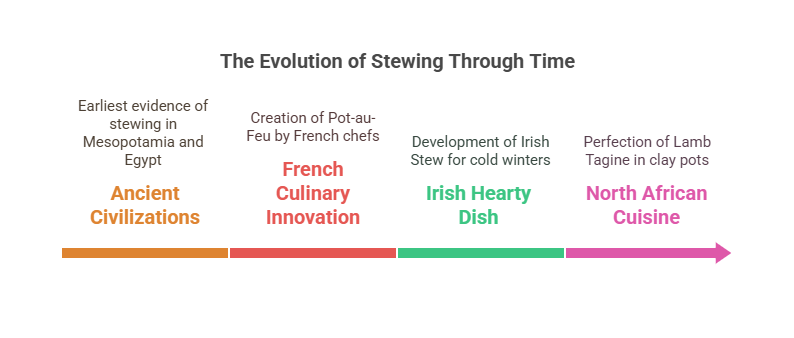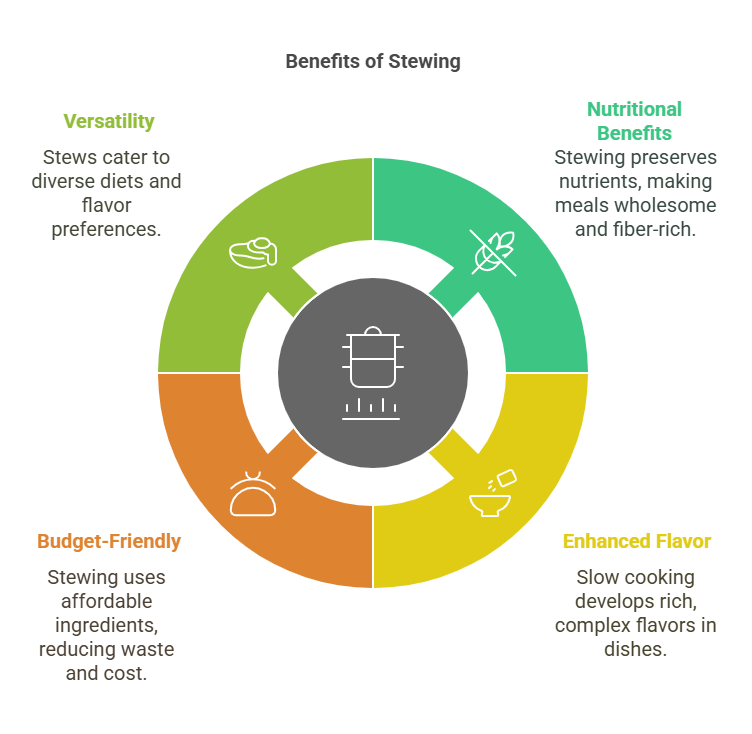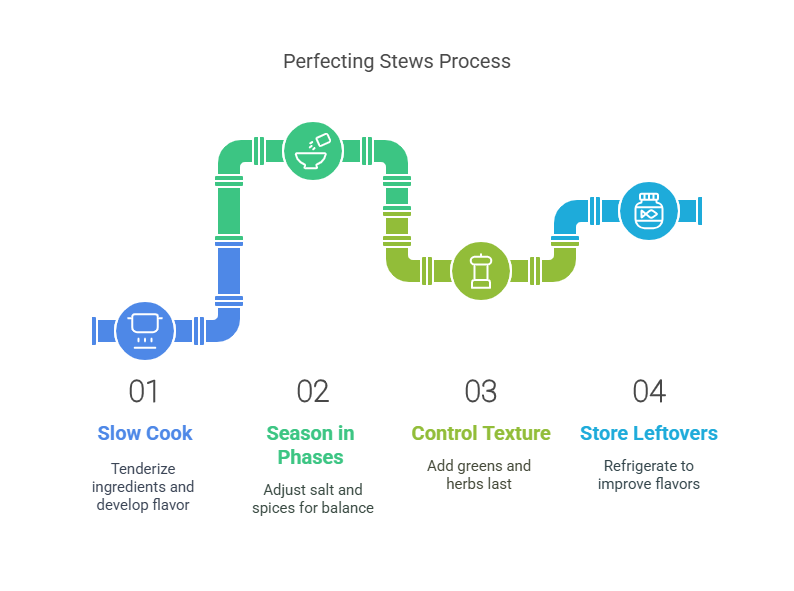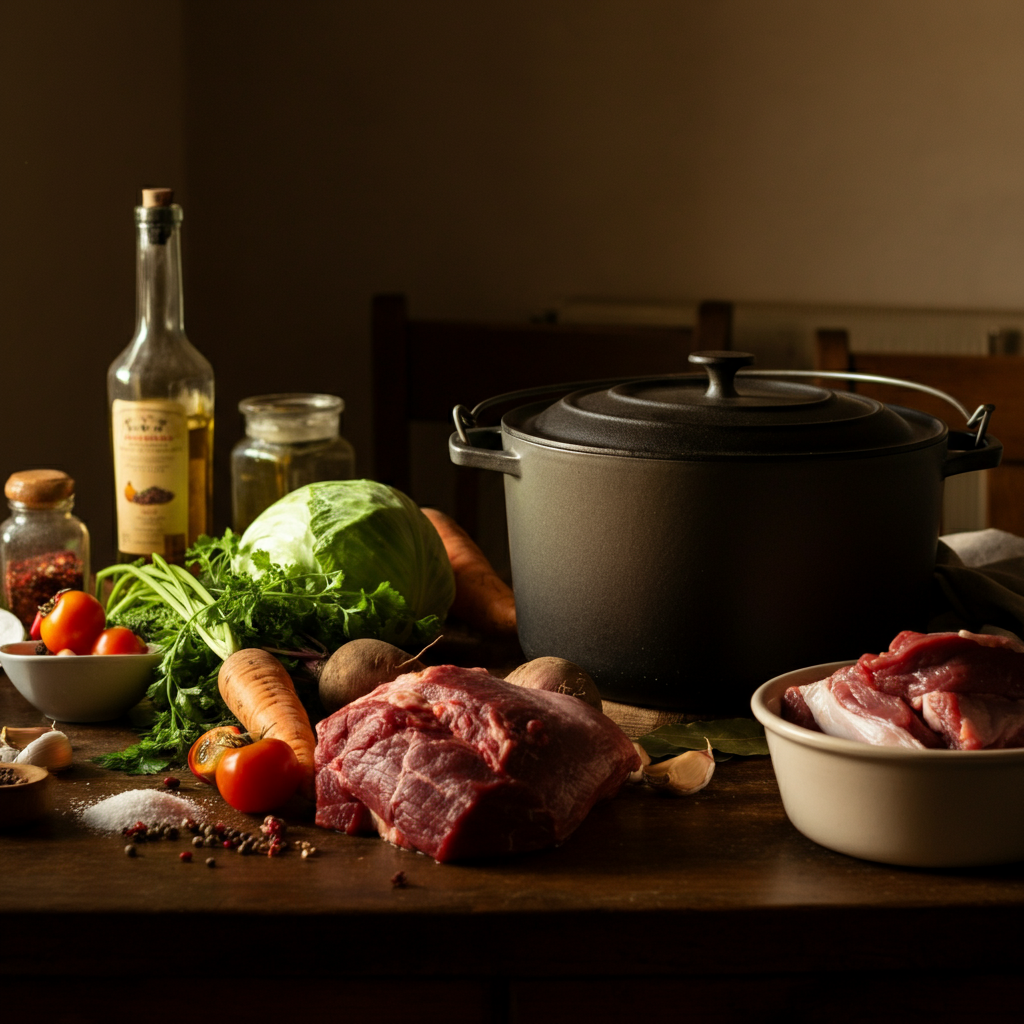Stews have a special kind of magic, don’t they? A pot shimmering gently on the stove, filling your kitchen with an aroma so comforting you feel wrapped in it. From hearty Irish Stews to Morocco’s fragrant Tagines, stewing has stood the test of time, effortlessly blending flavor, sustenance, and culture. But what makes this cooking method so beloved worldwide? And how can you perfect it in your own kitchen?
Stewing technique combines art and science, taking tougher, humbler ingredients and transforming them into dishes worthy of family dinners, celebrations, or moments when you need a warm hug in food form. Today, we’re breaking it all down—the history, techniques, benefits, and even recipes to try. By the end of this post, you’ll be set to stew like a pro!
1. A Brief History of Stewing Technique
Stewing technique is as old as fire itself—seriously! The earliest evidence of stewing can be traced all the way back to ancient civilizations such as Mesopotamia and Egypt. Early pots were used to slow cook meat, grains, and vegetables over open flames. Why? Stewing softens tough meats, makes vegetables tender and flavorful, and maximizes every last bit of sustenance.
Fast forward to centuries later, and the method evolved across cultures with unique twists. French chefs created the iconic Pot-au-Feu, a simple meat-and-vegetable stew still revered today. The Irish gave us Irish Stew, crafted to turn lamb or mutton into a hearty dish perfect for their cold winters. Meanwhile, North African kitchens perfected cuisine like Lamb Tagine, which layered irresistible spices with tender meat and veggies, cooked gently in clay pots.
What’s universal is stewing’s ability to make the most of affordable, accessible ingredients. This cooking style isn’t just culinary; it’s cultural and timeless.

2. What Is Stewing? Understanding the Basics
2.1 What Exactly Is Stewing?
Stewing technique is a combination cooking method where ingredients are browned or lightly sautéed, then slow-cooked in liquid until tender. It’s all about low, slow heat that allows flavors to meld beautifully. Unlike braising—which uses larger pieces of meat and only partially immerses them in liquid—stewing fully submerges smaller cuts of meat or ingredients. Think evenly cooked goodness in every bite.
2.2 How Stewing Works
Here’s where the magic happens. The slow cooking process breaks down tough fibers in meats, rendering them melty and flavorful. Meanwhile, vegetables release their sugars, deepening the dish’s sweetness and flavor. Over time, the liquid thickens into a sauce or gravy, turning your stew into a spoonful of concentrated deliciousness.
2.3 Common Ingredients in Stewing Technique
- Proteins: Beef chuck, lamb shank, chicken thighs—hearty cuts that benefit from slow cooking.
- Veggies: Root vegetables like carrots, parsnips, and potatoes, as well as onions and celery for aromatics.
- Broths & Liquids: Chicken stock, beef broth, wine, or even coconut milk add richness.
- Herbs & Spices: Bay leaves, thyme, rosemary, or paprika layer flavor.
Want to save money? Stewing technique makes the priciest-tasting meal out of the humblest ingredients.
3. The Benefits of Stewing Technique
Why stew? Aside from tasting insanely good, here are some compelling reasons to make it part of your cooking repertoire:
3.1 Nutritional Benefits
Stewing technique locks in nutrients, thanks to the slow, low heat. Vitamins and minerals from vegetables and meats stay in the liquid rather than evaporating, making this a wholesome meal. Plus, you’re getting filling, fiber-rich carbs in one comforting dish!
3.2 Enhanced Flavor
The extended cooking time develops layers of flavor that quicker methods simply can’t replicate. Ever tried Beef Bourguignon? It’s renowned worldwide for its deep, complex taste—a result of hours of simmering beef, wine, and bouquet garni.
3.3 Budget-Friendly
You don’t need filet mignon for a stew. Cuts like chuck roast or oxtail, which are often budget-friendly, shine in a stew. Leftover veggies past their prime? Toss them in too! Stewing reduces waste while saving your wallet.
3.4 Versatility
Stews suit every meal plan. Vegetarian? Try hearty Lentil Stew. Craving exotic flavors? Cook a spicy Kimchi Jjigae. Whether you cook in bulk for the week or whip up something cozy on a Sunday, stews fit the bill.

4. Stewing Techniques for Success
4.1 Choose the Right Ingredients
- Meats: Opt for tougher cuts with higher connective tissue—they become tender when stewed. Examples include beef brisket or pork shoulder.
- Liquids: Wine adds sophistication; stock offers heartiness; coconut milk introduces creamy, aromatic notes.
- Veggies: Don’t limit yourself to basics. Sweet potatoes, squash, or even turnips bring sweetness and depth.
4.2 Browning for Depth
Start by searing your proteins in the pot before adding liquids. This step—known as the Maillard reaction—creates complex, caramelized notes essential to a great stew.
4.3 Slow and Steady Wins the Race
Keep your stew simmering gently—not boiling. Too much heat toughens the meat and sponges out the flavor. Drop your temperature, and be patient—it’ll pay off.
4.4 Building Thickness
Want a heartier texture? Use a slurry (cornstarch + water) or create a roux. Alternatively, mash a few potatoes into the dish for natural thickening.
4.5 Optimize Kitchen Tools
While a heavy-duty Dutch oven is perfect for stovetop stews, Instant Pots and slow cookers offer set-it-and-forget-it convenience. Focus on consistency—steady hearth carries the day.
4.6 Layer Flavors Wisely
Build taste as you go. Brown onions and garlic early, then season incrementally throughout. Add delicate herbs like parsley toward the end to keep them bright.
Consistency, patience, and understanding your ingredients separate good stews from legendary ones.
5. Popular Stewing Recipes to Try
5.1 Classic Favorites
- Beef Bourguignon (France): Red wine, mushrooms, and beef create a rich, iconic stew.
- Irish Stew (Ireland): Hearty mutton or lamb mix with potatoes and onions.
- Coq au Vin (France): A chicken dish infused with wine and aromatics.
5.2 Global Delights
- Korean Kimchi Jjigae: Spicy, tangy, and perfect for fans of bold flavors.
- Moroccan Lamb Tagine: Fragrant spice, dried fruits, and lamb create harmony.
- Indian Chicken Curry Stew: Spiced simmered chicken in luscious gravy.
5.3 Vegetarian-Friendly Options
- Ratatouille: French veggie stew of peppers, eggplant, and zucchini.
- Lentil Stew: Packed with protein and fiber—perfect for plant-based eaters.
- Chickpea Tagine: North African flavors minus the meat.
Customize these recipes to match your pantry or preferences!
6. Tips for Perfecting Your Stews
- Patience is Key: Slow cook to tenderize ingredients and develop flavor.
- Season in Phases: Salt during cooking; adjust spices at the end for balance.
- Control Texture: Add greens and fresh herbs last to avoid mushiness.
- Store Leftovers Properly: Refrigerate in airtight containers—flavors often improve overnight!
Stews are forgiving, but these tips can take yours up a notch.

7. Common Mistakes to Avoid
Avoid overcrowding your pot—it lowers temperature and prevents proper cooking. Don’t under-season early; layers of salt are pivotal. Most of all, don’t rush—great stews can’t be hurried!
8. Why Stewing Technique Is a Sustainable Choice
Using inexpensive cuts, repurposed leftovers, and eco-friendly slow-cooking devices, stewing technique reduces waste and supports an earth-conscious lifestyle. It’s comfort food with a conscience.
9. Closing Thoughts
Stewing technique is more than a way to cook; it’s a celebration of flavor, time, and creativity. Whether you’re perfecting a French classic or experimenting with Moroccan spices, there’s no wrong way to stew. Grab a pot, gather your ingredients, and make magic.
Tried one of our recipes? Share your creations in the comments! Stay cozy and adventurous in your cooking—your stew pot awaits. And for more essential cooking tips, don’t forget to check out our guide on Cooking Methods. Happy cooking!
📌 Stay connected with us!
- Follow us on Instagram: @RoastedKitchen25 for daily cooking inspiration.
- Tag us in your creations using #RoastedKitchenstew—we’d love to see what you make!
- Subscribe to our newsletter for exclusive recipes, expert tips, and kitchen hacks straight to your inbox!
FAQ:
1. What are the best types of meat for stewing technique?
The best cuts of meat for stewing technique are tough, inexpensive cuts with higher connective tissue, such as beef chuck, brisket, pork shoulder, lamb shank, or chicken thighs. These cuts release gelatin during slow cooking, making the meat tender and the broth rich and flavorful.
2. How can I thicken a stew?
You can thicken a stew by:
- Mixing cornstarch or flour with cold water to make a slurry, then stirring it into the stew.
- Creating a roux (equal parts flour and fat) and adding it to the dish.
- Mashing some of the cooked potatoes or vegetables into the stew for a natural thickening effect.
3. What’s the difference between stewing technique and braising technique?
Both are combination cooking methods, but stewing technique fully submerges smaller cuts of meat and ingredients in liquid, while braising uses larger cuts of meat that are only partially submerged. Stews are typically heartier and evenly cooked, while braising is often used for roasts or whole meats.
4. Can I make stews in a slow cooker or Instant Pot?
Absolutely! Slow cookers are ideal for stews, offering a set-it-and-forget-it convenience. Instant Pots can also stew efficiently, with the added benefit of faster cooking times due to pressure cooking. Both methods yield tender meats and rich flavors, making them perfect for stewing.
5. How do I enhance the flavor of my stew?
- Brown your meat and vegetables before adding liquid to build depth of flavor.
- Season in stages, starting with salt early and adjusting spices or herbs toward the end of cooking.
- Use a flavorful liquid base like stock or wine.
- Add fresh herbs like parsley or cilantro as a final garnish to brighten the dish.
6. Can I make stews without meat?
Yes! Vegetarian stews can be just as hearty and flavorful. Lentils, chickpeas, root vegetables, mushrooms, and sweet potatoes make excellent bases. Enhance flavor with broth, spices, and aromatics like garlic and onions.
7. Why does stewing take so long?
Stewing technique uses low, slow heat to break down the connective tissue in tougher meats and draw out flavors from all the ingredients. This gradual process is key to achieving tender textures and a rich, cohesive flavor profile that faster methods cannot replicate.
8. Can I fix a bland stew?
If your stew tastes bland, try these fixes:
- Add acid like a splash of vinegar, lemon juice, or tomato paste to brighten flavors.
- Stir in a small amount of soy sauce or Worcestershire for umami depth.
- Adjust salt and seasoning levels. Sometimes a pinch of sugar can balance the overall flavor.
9. How do I store and reheat leftover stew?
Cool the stew completely before storing it in airtight containers in the refrigerator for up to 3-4 days. When reheating, warm it over low heat on the stovetop or in the microwave, stirring occasionally to ensure even heating. Many stews taste even better the next day as the flavors meld further.
These FAQ answers should help you tackle any stewing challenge, making the process easier and your results even tastier!

Hi, I’m Mayaz Ahsan!
As a passionate cook, storyteller, and food enthusiast, I combine my love for travel, farming, reading, and teaching to bring you insightful culinary tips and stories. Welcome to Roasted Kitchen – I’m thrilled to share this journey with you!










 Subscribe to our free newsletter for tips, tutorials, and insights!
Subscribe to our free newsletter for tips, tutorials, and insights!